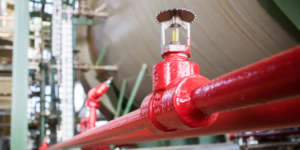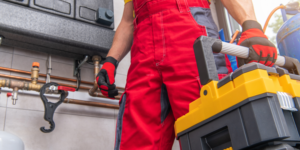Homeowners and property managers must maintain their fire sprinkler systems to protect their tenants. We will discuss the benefits of “Long-Neck” sprinkler covers and present an easy-to-follow approach to replacing Tyco LFII sprinklers.
Why use
When shopping for sprinkler covers, you may have heard of “long-neck” covers. But what are they and why use them? Allow me to explain.
As their name implies, long-neck covers are longer than ordinary covers. This extra length protects sprinklers from dirt, debris, and inadvertent damage. Long-neck covers protect sprinklers by extending above ground level.
Not only that! Maintenance and repairs are easier with long-neck coverings. These covers make sprinkler removal and replacement easier with their expanded necks. Long-neck covers save time and space by eliminating the need to dig to access sprinkler heads.
Step-by-step guide on how to change sprinklers on a Tyco LFII system
Many business and residential buildings employ Tyco LFII sprinkler systems for fire protection. Sprinklers may need to be replaced for maintenance or upgrading. Tyco LFII sprinkler replacement instructions are here.

- Safety first: Turn off the sprinkler system before starting work. This avoids inadvertent activation and water damage.
- Unscrew the old sprinkler from its fitting counterclockwise with a tool or pliers.
- Clean the threads: Use a soft cloth or brush to remove debris from the fitting and new sprinkler after removing the old one.
- Wrap multiple layers of thread sealant tape clockwise around your new sprinkling threads.
- Carefully screw the replacement sprinkler into the fitting clockwise until snug. Overtightening can damage threads or create leaks.
- Check for leaks: Restart the water supply and check the fitting and sprinkler for leaks. Apply extra thread sealant tape or tighten the sprinkler if leaks occur.
- Test the new sprinkler: After checking for leaks, activate a nearby fire alarm or flow switch. Sprinklers should spray water uniformly.
- Adjust the sprinkler: Use a wrench to gently align the sprinkler if the water is not spraying evenly or in the appropriate direction.
- Change other sprinklers: Repeat these steps for each sprinkler.
- Clean up: After installing and testing the new sprinklers, clean up your work area and switch on the water.
Follow manufacturer instructions and local building codes while working with fire protection equipment. Consult a specialist if you have any issues or are unclear about the steps.
Safety precautions when working with sprinklers
Safety is paramount while using sprinklers to boost irrigation system performance. Note these necessary precautions:
- Turn off the water supply before working on sprinklers. Prevents inadvertent spraying or flooding.
- Protect yourself: Wear gloves and goggles to avoid chemical exposure and damage.
- Turn off the power before handling electrical connections in your sprinkler system. This reduces electric shock risk.
- utilize tools properly: When performing maintenance or repairs, hold them securely and utilize them as intended.
- Work on firm ground: Use sturdy ladders or flat surfaces to reach sprinkler heads. Avoid working at heights and take extra precautions.
Follow these safety procedures to avoid accidents and injuries when working with sprinklers in your Tyco LFII system or any irrigation system.
Common mistakes to avoid when changing sprinklers
To change sprinklers on a Tyco LFII system smoothly, avoid these mistakes. Be aware of these blunders, which might damage the sprinkler system or cause inappropriate installation.
Not shutting off the water before changing the sprinklers is a common mistake. This seems apparent, yet it’s easy to overlook in the thrill of starting. A messy flood and water damage might happen from not turning off the water.
Another problem is using the wrong tools or methods to remove or install sprinklers. Tyco-recommended tools for your LFII system are essential. Incorrect tools can damage sprinkler heads and fittings, causing leaks or malfunctions.
Maintenance tips for Tyco LFII systems
To maximize performance and longevity, your Tyco LFII sprinkler system needs regular maintenance. Important tips to remember:
- Visually examine sprinkler heads, pipes, and fittings regularly. Check for wear, corrosion, and damage.
- Clean Sprinkler Heads: Dust, grime, and debris can reduce sprinkler head efficiency over time. Cleaning and unblocking them using a soft brush or cloth.

- Test Your System: Your Tyco LFII system must be tested regularly to ensure optimal operation. Active each zone and check if all sprinklers come up and disperse water equally.
- Check Water Pressure: Use a pressure gauge to check water pressure throughout your system. Keep it within Tyco’s recommended range.
- Keep Clear Surroundings: Trim plants near sprinkler heads to prevent clogs.
These suggestions should be used in conjunction with Tyco’s LFII system model-specific maintenance instructions.
Conclusion
Always put safety first when using sprinklers. Wear safety gear, switch off the water supply, and be cautious of nearby hazards.
Avoiding typical sprinkler replacement mistakes saves time and prevents difficulties. A successful replacement requires double-checking measurements, utilizing proper instruments, and seeking professional help if needed.
Tyco LFII systems need regular maintenance to perform well. Sprinklers should be inspected routinely for damage or obstructions to prevent major concerns. Testing the system’s functionality regularly ensures its emergency reliability.
By knowing when to use “Long-Neck” covers and how to adjust sprinklers on a Tyco LFII system, you can keep people and property safe.
If you have questions about changing or maintaining your sprinkler system, contact manufacturer instructions or a professional. Stay safe!
